Module 3: Aristotelian Logic
3.1 Classes and Categorical Propositions
Aristotelian logic evaluates arguments that are expressed within a precisely delimited subset of the language. This strategy may seem overly restrictive: if we limit ourselves to arguments expressed in a limited vocabulary and we might wonder if we are going to miss lots of (all?) arguments that we care about? Our answer is that the approach is not as restrictive as it might seem. We can translate back and forth between the special portion of language in Aristotelian Logic and expressions in natural language that are outside its scope.
3.1.1 Building Blocks of Aristotelian Logic
For Aristotle, the fundamental logical unit is the class.
Classes are just sets of things—sets that we can pick out using language.
The simplest way to identify a class is by using a plural noun: trees, clouds, asteroids, people—these are all classes. Names for classes can be grammatically more complex, too. We can modify the plural noun with an adjective: ‘rich people’ denotes a classes (in more ways than one.) Prepositional phrases can add further specificity: ‘rich people from Italy’ picks out a different class. The modifications can go on indefinitely: ‘rich people from Italy who made their fortunes in real estate and whose grandmothers were rumored to be second cousins of Benito Mussolini picks out yet another class—which is either very small or possibly empty. Who knows! (Empty classes are just classes with no members; we’ll talk more about them later.)
We will refer to the names of classes as ‘class-terms’, or just ‘terms’ for short. Since for Aristotle, the fundamental logical unit is the class, and since terms are the bits of language that pick out classes, Aristotle’s logic is often referred to as a ‘term logic’. (This is in contrast to the logic we will study in the next unit – Sentential logic, which takes the proposition as its fundamental logical unit, and sentences are the linguistic vehicle for picking those out.)
Of course, Aristotelian Logic must also deal with propositions—we’re evaluating arguments here, and by definition, as we know, those are just sets of propositions. But since classes are the fundamental logical unit, Aristotle restricts himself to a particular kind of proposition: categorical propositions. ‘Category’ is just a synonym of ‘class’. Categorical propositions are propositions that make a claim about the relationship between two classes. This is the first step in taming natural language: Aristotelian Logic will only evaluate arguments made up entirely of categorical propositions. We’re limiting ourselves to a restricted portion of language—sentences expressing these kinds of propositions, which will feature two class terms—terms picking out the classes whose relationship is described in the categorical proposition.
Check Your Understanding
3.1.2 The Four Types of Categorical Proposition
Again, categorical propositions make an assertion about the relationship between two classes. There are three possible relationships that can be asserted:
Whole Inclusion: one class is contained entirely within the other.
Example: Class 1 = Beagles, Class 2 = dogs. The first class is entirely contained in the second; every Beagle is a dog.
Partial Inclusion: one class is partially contained within the other; the two classes have at least one member in common.
Example: Class 1 = people; Class 2 =swimmers. Some people swim, some do not. And some swimmers are people while other swimmers are not (they are fish perhaps.) These two classes overlap but not entirely.
Exclusion: the two classes don’t have any members in common; they are exclusive.
Example: Class 1 = mammals; Class 2 = birds. No mammals are birds; no birds are mammals.
Given these considerations, we can (more or less) formally define categorical propositions in this way:
A categorical proposition is a claim about the relationship between two classes—call them S and P—that either affirms or denies that S is wholly or partially included in P. (Note that denying that S is even partially included in P is the same as affirming that S and P are exclusive.)
Aristotle noted that, given this definition, there are four types of categorical propositions.
We now take a close look at each of the four types of categorical propositions. The official name for each type is a mouthful, and by convention, each has become known by the single-letter nickname noted in parentheses as the proposition type:
- Universal Affirmative (A)
- Universal Negative (E)
- Particular Affirmative (I)
- Particular Negative (O)
In discussing the four types, we will use ‘S’ and ‘P’ as the symbols for generic class terms when we are not using specific classes of things as our examples. ’S’ and ‘P’ work well because the former is the grammatical subject (S) of the sentence/proposition, and the latter is the grammatical predicate (P).
Additional conventions that apply to all four types of categorical propositions will be explained in detail as we examine the first type of proposition. When we work on the last three types of propositions, we will already know about these conventions.
Universal Affirmative (A)
This type of proposition affirms the inclusion of the entire class S (all members of the class) in the predicate class P—it says that each member of S is also a member of P. The standard expression of this proposition is a sentence of the form ‘All S are P’.
The A type of proposition affirms whole inclusion. For example, the sentence ‘All men are mortals’ expresses a proposition of this type, one that is true. ‘All men are Canadians’ also expresses a universal affirmative proposition, one that is false.
Now let’s choose specific subject and predicate classes to use in an example: let S = camels and P = mammals. The A proposition featuring these two classes is expressed as ‘All camels are mammals” which happens to be true.
When it comes time to test arguments for validity—the last step in the process we’ve just begun — it will be convenient for us to represent the four types of categorical propositions graphically.
The basic form of the pictures will be two overlapping circles, with the left-hand circle representing the subject class and the right-hand circle representing the predicate class. Like this:
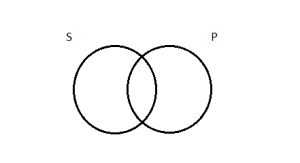
To depict the four types of categorical propositions graphically, we’ll modify this basic two-circle diagram by shading in parts of it or making marks inside the circles.
Before we get to the specific depiction of the A proposition, let’s talk about the basic two-circle diagram. There are four regions, to which we can assign numbers as labels:
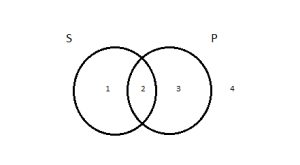
Let’s talk about what’s inside each of the four regions if we take S to be the class of camels and P to be the class of mammals.
Region 1 is the portion of the S circle that doesn’t overlap with the P circle. These are things in the subject class but outside the predicate class; they are camels that are not mammals. To the best of our knowledge, none of these exist.
Region 2 is the area of overlap between the subject and predicate classes; residing here are things that are both camels and mammals; they are members of both classes.
Region 3 is the portion of the P circle that doesn’t overlap with S. These are members of the predicate class—mammals, in our example—who are not members of the subject class—not camels. This is where the non-camel mammals live —- humans and so many other species.
Region 4 is all the things that are outside both the subject and predicate classes—things that are neither camels nor mammals. Everything else in the universe.
What we want to figure out next is how to alter that diagram so that we end up with a picture of the universal affirmative proposition. Our particular example of an A proposition is ‘All camels are mammals.’ How do we draw a picture of that, using the two circles as our starting point? Think about it this way: when we say all camels are mammals, what we’re really saying is that a certain kind of thing doesn’t exist; there’s no such thing as a non-mammal camel. In other words, region 1 is empty, according to the A proposition. To depict emptiness, we will adopt the convention of shading in the relevant region(s) of the diagram. So our picture of the universal affirmative looks like this:
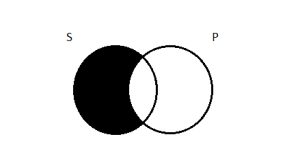
All S are P means that you will not find any members of S that are outside the P circle (no camels that are not mammals). The place in the diagram where such things would be has been shaded to indicate it is empty. The only portion of S that remains as a viable space is inside the P circle, in what we called region 2 (any camels you can find will be mammals).
One might reasonably ask at this point: why did we draw the universal affirmative that way, instead of another, alternative and possibly more intuitive way? A-type propositions affirm whole inclusion—that S in entirely contained within P. An obvious alternative way to depict that state of affairs could look like this:

S is contained entirely within P. Why bother with the overlapping circles and the shading?
There’s nothing wrong with this alternative depiction of the universal affirmative; it captures the claim being made. Still, we adopt the overlapping-circles depiction because it works for all four types of categorical propositions, and to test arguments for validity, we will need uniform diagrams — the same basic two-overlapping-circle diagram, with shading and marks inside.
These diagrams, as you may know, are called Venn
diagrams. They are named after the 19th-century English logician John Venn, who invented them specifically as an easier means of testing arguments for validity in Aristotelian Logic (things were more unwieldy before Venn’s innovation).
Check Your Understanding
Universal Negative (E)
The E type of proposition denies that S is even partially included in P. Put another way: it affirms that S and P are exclusive—that they have no members in common. The standard expression of this proposition is a sentence of the form ‘No S are P’.
So, for example, the sentence ‘No dogs are cats’ expresses a true universal negative proposition; the sentence ‘No animals are cats’ expresses a false one.
Again, we want to think about how to depict this type of proposition using the standard two-circle Venn diagram. So let’s choose a specific subject and predicate classes to use as an example for an E proposition: let S = camels and P = reptiles. The E proposition featuring these two classes is expressed as ‘No camels are reptiles” which is true (by design!)
Think about this proposition, that no camels are reptiles. How do we draw a picture of this claim? Well, as we said, E propositions tell us that the two classes don’t have any members in common. The region of the two-circle diagram where there are members of both classes is the area of overlap in the picture (what we referred to as region 2 above). The universal negative proposition tells us that there’s nothing in there. So if I claim that no camels are reptiles, I’m saying that there’s no such thing as a reptilian camel. Region two is empty, and so we shade it out:
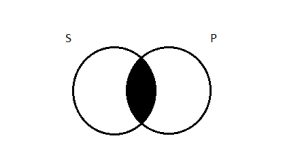
Particular Affirmative (I)
The I type of proposition affirms that the S class is partially included in P. Its standard expression is a sentence of the form ‘Some S are P’.
The proposition ‘Some sailors are pirates’ expresses a true particular affirmative proposition, and ‘Some sumo wrestlers are pigeons’ expresses a false one.
Before talking about how to depict I propositions with a Venn diagram, it is important to discuss the word ‘some’. Remember, in Aristotelian Logic we’re taming natural language by restricting ourselves to a well-behaved portion of it—sentences expressing categorical propositions. We’re proposing to use sentences with the word ‘some’ in them. ‘Some’, however, is not particularly well-behaved, and we’re going to have to get it in line before we proceed.
Consider this utterance: Some registered voters are gun owners.
This is true, and it communicates to the listener the fact that there’s some overlap between the classes of registered voters and gun owners. But it also communicates something more—namely, that some of those registered voters are not gun owners. This is a fairly typical implicature (recall our discussion of this linguistic phenomenon in Unit 2, when we looked at the Fallacy of Equivocation): when we say that some are, we also communicate that some are not.
But there are times when we use ‘some’ and do not make the implication that some are not. Suppose you’re talking to your mom, and you mention that you’re reading a logic book. For some reason, your mom’s always been curious about logic books and asks you whether they’re a good read. You respond, Well, mom, I can tell you this for sure: Some logic books are boring. You should see this book I’m reading now; it’s a total snooze-fest!
In this case, you say that some logic books are boring based on your experience with this particular book, but you do not implicate that some logic books are not boring; for all you know, all logic books are boring—it’s just impossible to write an exciting logic book. This is a perfectly legitimate use of the word ‘some’, where all it means is that there is at least one: when you utter ‘some logic books are boring’, all you communicate is that there is at least one boring logic book (the one you’re reading).
This is a bit of natural-language unruliness that we must deal with: sometimes when we use the word ‘some’, we implicate that some are not; other times, we don’t, only communicating that at least one is. When we use ‘some’ in Aristotelian Logic, we need to know precisely what’s being said. So we choose that ‘some’ means ‘there is at least one’. ‘Some S are P’ tells us that those two classes have at least one member in common, and nothing more. ‘Some sailors are pirates’ means that there’s at least one sailor who’s also a pirate, and that’s it. There is no implication that some sailors are not pirates; only that at least one of them is; we just don’t know about the rest of them.
This can confuse people, so it’s worth repeating and emphasizing:
‘Some’ means ‘there is at least one’. It does not imply that some are not.
With that out of the way, we can turn our attention to the Venn diagram for the particular affirmative I proposition. It makes the assertion that S and P have at least one member in common. So let’s choose specific subject and predicate classes to use as an example for an I proposition: let S = reptiles and P = herbivores. The I proposition featuring these two classes is expressed as ‘Some reptiles are herbivores’ which is true. How do we draw a picture of this? We need to indicate that there’s at least one thing in the area of overlap between the two circles on the diagram—at least one thing inside of region 2. We do this by drawing an X:
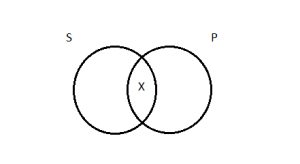
Check Your Understanding
Particular Negative (O)
The O type of proposition denies that S is wholly included in P. It claims that there is at least one member of S that is not a member of P. Given that ‘some’ means ‘there is at least one’, the standard expression of this proposition is ‘Some S are not P’—there’s at least one member of S that the two classes do not have in common.
‘Some sailors are not pirates’ expresses a true particular negative proposition; ‘Some dogs are not animals’ expresses a false one.
The Venn diagram for O propositions is simple. We need to indicate, on our picture, that there’s at least one thing that’s inside of S, but outside of P. So let’s choose specific subject and predicate classes to use as an example for an O proposition: let S = meat eaters and P = mammals. We need to put a mark for a meat eater that is not a mammal (an alligator perhaps) inside the S circle, but outside the P circle.
As with the diagram for the I proposition, we indicate the existence of at least one such thing by drawing an X in the appropriate place:
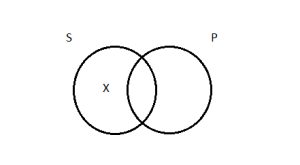
Check Your Understanding
3.1.3 Quantity and Quality
Each of the four types of categorical propositions has what we refer to as a ‘quantity’ and a ‘quality.’ There are two quantities: universal and particular. There are two qualities: affirmative and negative. There are four possible combinations of quantity and quality, hence four types of categorical propositions:
- Universal Affirmative (A)
- Universal Negative (E)
- Particular Affirmative (I)
- Particular Negative (O)
The universal propositions—A and E, affirmative and negative—are so-called because they each make a claim about the entire subject class. If it is claimed that ‘all hobos are whiskey drinkers,’ an assertion is made that covers every single hobo, every member of that class. Similarly, if a claim is made that ‘no chickens are race car drivers’, an assertion covering all the chickens is made—they all fail to drive race cars.
The particular propositions—I and O, affirmative and negative— on the other hand, do not make claims about every member of the subject class. ‘Some dinosaurs were herbivores’ just makes the claim that there was at least one plant-eating dinosaur; we don’t learn about all the dinosaurs. Similar remarks apply to an O proposition like ‘Some dinosaurs were not carnivores’. Remember, ‘some’ just means ‘at least one’.
The affirmative propositions—A and I, universal and particular—make affirmative claims about the relationship between two classes. Propositions affirm whole inclusion; I propositions affirm partial inclusion. [The Latin word meaning ‘I affirm’ is affirmo; the A and the I in that word are where the one-letter nicknames for the universal and particular affirmatives come from.]
The negative propositions—E and O, universal and particular—make negative claims about the relationship between two classes. E propositions deny even partial inclusion; O propositions deny whole inclusion. [The Latin word meaning ‘I deny’ is nego; the E and the O in that word are where the one-letter nicknames for the universal and particular negatives come from.]
Check Your Understanding
3.1.4 Standard Form for Categorical Propositions
To tame natural language, Aristotelian Logic limits itself to that portion of language that expresses categorical propositions. Above, we gave standard
sentences for each of the four types of categorical propositions: ‘All S are P’ for the universal affirmative; ‘No S are P’ for the universal negative; ‘Some S are P’ for the particular affirmative; and ‘Some S are not P’ for the particular negative. These are not the only ways of expressing these propositions in English, but we will restrict ourselves to these standard forms. That is, we will only evaluate arguments whose premises and conclusions are expressed with sentences with these standard forms.
Generally speaking, here is the template for sentences qualifying as standard form:
[Quantifier] Subject Term <copula> (not) Predicate Term
- Standard form sentences begin with a quantifier—a word that indicates the quantity of the categorical proposition expressed. Only sentences beginning with ‘All’, ‘No’, or ‘Some’ qualify as standard form categorical propositions.
- Subject and predicate terms pick out the two classes involved in the categorical proposition. Subject and predicate terms must be nouns or noun-phrases (nouns with modifiers) in order for a sentence to be in standard form.
- The copula is a version of the verb ‘to be’ (‘are’, ‘is’, ‘were’, ‘will be’, etc.). It doesn’t matter which version of the copula occurs in the sentence; it may be any number or tense. ‘Some sailors are pirates’ and ‘Some sailors were pirates’ both count as standard form, for example.
- The word ‘not’ occurs in the standard form expression of the particular negative O proposition: for example, ‘Some sailors are not pirates’. Restriction: the word ‘not’ can only occur in sentences expressing O propositions; ‘not’ appearing with any quantifier other than ‘some’ is a deviation from standard form.
Check Your Understanding
We now have a precise delimitation of the portion of natural language to which Aristotelian Logic restricts itself: only sentences in standard form. But now a worry that we raised earlier becomes acute: if we can only evaluate arguments whose premises and conclusions are expressed with standard form sentences, aren’t we severely, perhaps ridiculously, constrained? Has anyone, ever, outside a logic book, expressed a real-life argument that way? This is where translation comes in.
3.1.5 Translating Ordinary Language to Standard Form
Lots of sentences that are not in standard form can be translated into standard form sentences that have the same meaning. Aristotle himself believed that all propositions, no matter how apparently complex or divergent, could ultimately be analyzed as one of the four types of categorical propositions. Though this is, to put it mildly, not a widely held belief today, it still had an enormous influence on the history of logic, since Aristotle’s system was preeminent for more than 2,000 years. Over that time, logicians developed ever more elaborate procedures for analyzing a dizzying variety of non-Standard form sentences as expressing one of the four types of categorical propositions and translating them accordingly. An exhaustive survey of those inquiries would be exhausting and beyond the scope of this course. It will be enough to look at a few simple examples to get an idea of how many apparently deviant expressions can be treated by Aristotelian Logic. Our goal is simply to allay concerns that in restricting ourselves to standard form sentences we are severely limiting our logic’s power to evaluate real-life arguments.
Let’s consider the first deductively valid argument we encountered in this book, the one about Socrates: All men are mortal; Socrates is a man; therefore, Socrates is mortal. This argument has three propositions in it, but none of the three sentences expressing them are in standard form. The first sentence, ‘All men are mortal’, may appear to fit the bill, but it has a subtle flaw: ‘mortal’ is an adjective, not a noun. Class terms are required to be nouns or noun phrases. But this is an easy fix: add an ‘s’ to the end and you get a plural noun. ‘All men are mortals’ is in standard form; it expresses a universal affirmative, A proposition. This prescription applies generally. Predicate adjectives can be replaced with suitable noun phrases most easily by just inserting the generic noun ‘things’: ‘Some men are handsome’ becomes ‘Some men are handsome things’; ‘No rockstars are silly’ becomes ‘No rockstars are silly things’.
Back to the Socrates argument. The second premise is also problematic: ‘Socrates is a man’. First of all, it doesn’t have a quantifier. Second, its subject term, ‘Socrates’, picks out an individual person; we’re supposed to be dealing with classes here. Well, that’s right, but it’s not really a problem. We can just make the subject class a unit class—a class containing exactly one member, namely Socrates. Now we can understand the sentence as expressing the claim that the single member of that class is also a member of the class of men. That is, it’s a universal affirmative— there’s whole inclusion of the Socrates unit-class in the class of men. The sentence we need, then, starts with the quantifier ‘All’, and to make the grammar work, we pick a plural noun to name the Socrates class: ‘All Socrateses are men’. Is ‘Socrateses’ the plural of ‘Socrates’? I can’t think of anything better. Anyway, the point is, that word picks out a class that has exactly one member, Socrates. Sentences with singular subjects can be rendered as universals. If we had the sentence ‘Socrates is not alive’, we could render it as a universal negative: ‘No Socrateses are living things’.
There are other things to consider. English comes with a variety of quantifier words: ‘each’, ‘every’, ‘any’, and so on. Common sense tells us how to translate sentences featuring these into standard form: switch to the appropriate standard form quantifier—‘All’, ‘No’, or ‘Some’. ‘Every teacher is a hard worker’ becomes ‘All teachers are hard workers’, for example. Sometimes quantifier words are omitted, but it’s clear from context what’s going on. ‘Dogs are animals’ means ‘All dogs are animals’; ‘People are waiting in line’ can be rendered as ‘Some people are things that are waiting in line’.
Sometimes sentences have a verb other than the copula. ‘Some people eat rabbit’, for example, can be translated into ‘Some people are rabbit-eaters’. Sometimes the word ‘not’ appears in a sentence that has a quantifier other than ‘some’. ‘Not all mammals are carnivores’, for example, can be translated into ‘Some mammals are not carnivores’.
The list goes on. Centuries of work has been done on the task of translating sentences into standard form. We can stop here, and simply accept that the restriction to standard form sentences does not seriously limit the arguments that Aristotelian Logic can evaluate.
Skills Practice
Translate these statements into standard-form categorical propositions:
- A few students work as library assistants.
- All donors are generous.
- Some team members run sprints.
- Every kid on the team won a trophy.

